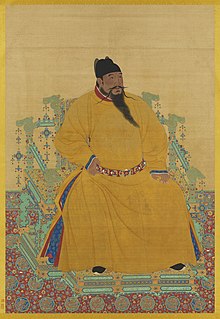
Back Yongle Afrikaans الإمبراطور يونغلي Arabic الامبراطور يونجلى ARZ یونقلو AZB Юнлэ Byelorussian Мин Юнлъ Bulgarian Yǒnglè Catalan Īng-lŏk Huòng-dá̤ CDO ئیمپراتۆر یۆنگڵ CKB Jung-le Czech
| Yongle Emperor 永樂帝 | |||||||||||||||||
|---|---|---|---|---|---|---|---|---|---|---|---|---|---|---|---|---|---|
 | |||||||||||||||||
| Emperor of the Ming dynasty | |||||||||||||||||
| Reign | 17 July 1402 – 12 August 1424 | ||||||||||||||||
| Enthronement | 17 July 1402 | ||||||||||||||||
| Predecessor | Jianwen Emperor | ||||||||||||||||
| Successor | Hongxi Emperor | ||||||||||||||||
| Prince of Yan | |||||||||||||||||
| Tenure | 2 May 1370 – 17 July 1402 | ||||||||||||||||
| Successor | Himself as emperor | ||||||||||||||||
| Born | 2 May 1360 Yuan Zhizheng 20, 17th day of the 4th month (元至正二十年四月十七日) Yingtian Prefecture, Ming dynasty (present-day Nanjing, Jiangsu Province, China) | ||||||||||||||||
| Died | 12 August 1424 (aged 64) Ming Yongle 22, 18th day of 7th month (明永樂二十二年七月十八日) Khailas-ausu (Yumuchuan), Ming dynasty (present-day Duolun County, Inner Mongolia, China) | ||||||||||||||||
| Burial | 8 January 1425 Changling Mausoleum, Ming tombs, Beijing | ||||||||||||||||
| Spouse | |||||||||||||||||
| Issue |
| ||||||||||||||||
| |||||||||||||||||
| House | Zhu | ||||||||||||||||
| Dynasty | Ming | ||||||||||||||||
| Father | Hongwu Emperor | ||||||||||||||||
| Mother | Empress Xiaocigao | ||||||||||||||||
| Religion | Confucianism | ||||||||||||||||
| Yongle Emperor | |||||||||||||||||||||
|---|---|---|---|---|---|---|---|---|---|---|---|---|---|---|---|---|---|---|---|---|---|
 "Yongle Emperor" in Traditional (top) and Simplified (bottom) Chinese characters | |||||||||||||||||||||
| Traditional Chinese | 永樂帝 | ||||||||||||||||||||
| Simplified Chinese | 永乐帝 | ||||||||||||||||||||
| Literal meaning | "Perpetual Happiness" | ||||||||||||||||||||
| |||||||||||||||||||||
The Yongle Emperor (2 May 1360 – 12 August 1424), personal name Zhu Di (Chinese: 朱棣; pinyin: Zhū Dì; Wade–Giles: Chu Ti), was the third emperor of the Ming dynasty, reigning from 1402 to 1424.
Zhu Di was the fourth son of the Hongwu Emperor, the founder of the Ming dynasty. He was originally enfeoffed as the Prince of Yan (燕王) in May 1370,[1] with the capital of his princedom at Beiping (modern Beijing). Zhu Di was a capable commander against the Mongols. He initially accepted his father's appointment of his eldest brother Zhu Biao and then Zhu Biao's son Zhu Yunwen as crown prince, but when Zhu Yunwen ascended the throne as the Jianwen Emperor and began executing and demoting his powerful uncles, Zhu Di found pretext for rising in rebellion against his nephew.[1] Assisted in large part by eunuchs mistreated by the Hongwu and Jianwen Emperors, who both favored the Confucian scholar-bureaucrats,[2] Zhu Di survived the initial attacks on his princedom and drove south to launch the Jingnan campaign against the Jianwen Emperor in Nanjing. In 1402, he successfully overthrew his nephew and occupied the imperial capital, Nanjing, after which he was proclaimed emperor and adopted the era name "Yongle", which means "perpetual happiness".
Eager to establish his own legitimacy, Zhu Di voided the Jianwen Emperor's reign and established a wide-ranging effort to destroy or falsify records concerning his childhood and rebellion.[1] This included a massive purge of the Confucian scholars in Nanjing[1] and grants of extraordinary extralegal authority to the eunuch secret police.[2] One favorite was Zheng He, who employed his authority to launch major voyages of exploration into the South Pacific and Indian Oceans. The difficulties in Nanjing also led the Yongle Emperor to re-establish Beiping (present-day Beijing) as the new imperial capital. He repaired and reopened the Grand Canal and, between 1406 and 1420, directed the construction of the Forbidden City. He was also responsible for the Porcelain Tower of Nanjing, considered one of the wonders of the world before its destruction by the Taiping rebels in 1856. As part of his continuing attempt to control the Confucian scholar-bureaucrats, the Yongle Emperor also greatly expanded the imperial examination system in place of his father's use of personal recommendation and appointment. These scholars completed the monumental Yongle Encyclopedia during his reign.
The Yongle Emperor died while personally leading a military campaign against the Mongols. He was buried in the Changling Mausoleum, the central and largest mausoleum of the Ming tombs located north of Beijing.
Cite error: There are <ref group=lower-alpha> tags or {{efn}} templates on this page, but the references will not show without a {{reflist|group=lower-alpha}} template or {{notelist}} template (see the help page).
- ^ a b c d Chan Hok-lam. "Legitimating Usurpation: Historical Revisions under the Ming Yongle Emperor (r. 1402–1424)". The Legitimation of New Orders: Case Studies in World History. Chinese University Press, 2007. ISBN 978-9629962395. Accessed 12 October 2012.
- ^ a b Crawford, Robert B. "Eunuch Power in the Ming Dynasty". T'oung Pao, 2d Series, Vol. 49, Livr. 3 (1961), pp. 115–148. Accessed 9 October 2012.
© MMXXIII Rich X Search. We shall prevail. All rights reserved. Rich X Search